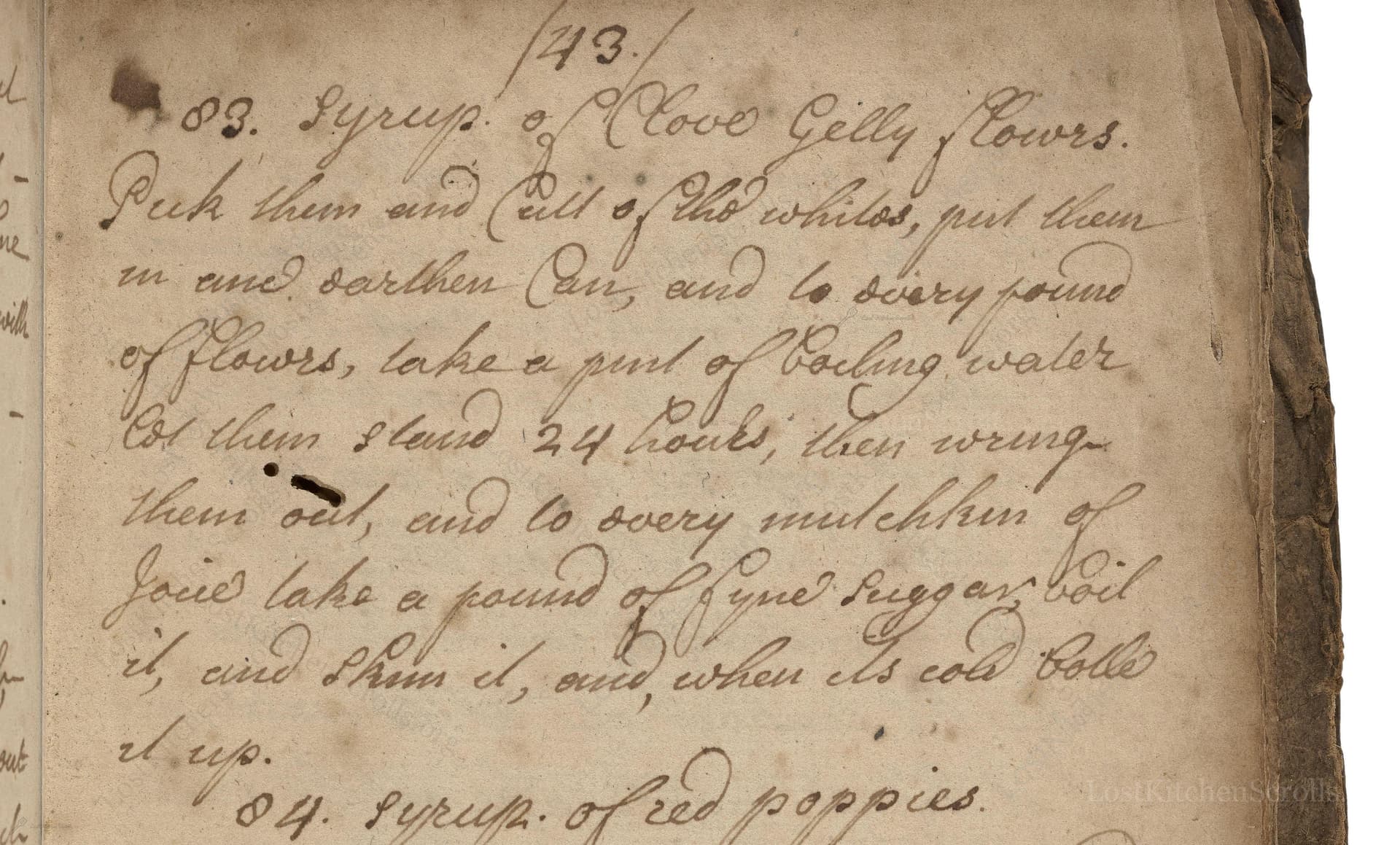Syrup Of Clove Gelly Flowers
From the treasured pages of Receipts for cookery and pastry work
Written by Mrs. Johnston

Syrup Of Clove Gelly Flowers
"Peck them and Cutt of the whites, put them in ane earthen Can, and to every pound of Flowers, take a pint of Boiling water. let them stand 24 houres, then wring them out, and to every mutchkin of Joice take a pound of fyne suggar, boil it, and skum it, and when its cold bottle it up."
Note on the Original Text
The recipe is written in the straightforward, abbreviated style of early modern manuscript cookery books. Weights and measures like 'pound' and 'mutchkin' (an old Scottish measure, roughly 425 ml) are used casually, assuming the reader's familiarity. Spelling varies (‘fyne suggar’ for fine sugar; ‘Joice’ meaning juice), but language is practical and task-focused, and instruction is by action rather than exact timing or temperature. Such recipes expect the cook’s intuition, and modern adaptation relies on interpreting period weights and English-to-modern English clarifications.

Title
Receipts for cookery and pastry work (1700)
You can also click the book image above to peruse the original tome
Writer
Mrs. Johnston
Era
1700
Publisher
Unknown
Background
A delightful compilation of 18th-century recipes gathered by Mrs. Johnston herself, promising a charming journey through the flavors and culinary traditions of the early 1700s.
Kindly made available by
Folger Shakespeare Library
This recipe originates from around 1700, compiled by Mrs. Johnston. The early 18th century in Britain saw the flourishing of manuscripts recording culinary and medicinal recipes. Clove gillyflowers were prized for their spicy, perfumed scent, more closely resembling cloves than any actual flower. Syrups like this would have been used medicinally or as flavorings for desserts, drinks, and cordials—adding a touch of both sophistication and luxury to the household table. The careful use of various flowers for syrups and preserves was at its height among the well-to-do families who had access to gardens and skilled household staff. This recipe reflects both the abundance and whimsy of early modern English kitchen gardens and the prevailing belief in flowers' health-giving virtues.

In the early 1700s, the process would start with a kitchen maid using a sharp knife or scissors to carefully cut the flower petals, discarding the bitter whites. The infusion would be made in a glazed earthenware can or bowl. For straining and wringing, clean linen cloths or muslin bags would be used. The syrup would then be boiled in a copper or iron pan over an open hearth, with a wooden spoon or skimmer to remove froth. Once cooled, the syrup would be poured into glass bottles, which were often stoppered with cork and sealed with wax.
Prep Time
15 mins
Cook Time
30 mins
Servings
15
We've done our best to adapt this historical recipe for modern kitchens, but some details may still need refinement. We warmly welcome feedback from fellow cooks and culinary historians — your insights support the entire community!
Ingredients
- 1 pound clove gillyflower (Dianthus caryophyllus) petals (remove white base of each petal)
- 1 pint boiling water
- 1 pound caster sugar (fine white sugar)
Instructions
- First, remove the petals from your clove gillyflowers (commonly identified as Clove Pink, a type of Dianthus).
- Discard the white bases of the petals to avoid bitterness.
- For each 1 pound of petals, pour over 1 pint of boiling water in a ceramic or glass bowl.
- Cover and leave to infuse at room temperature for 24 hours.
- After infusion, strain and squeeze out all the liquid from the petals.
- For every 15 fluid ounces of the resulting infusion, add 1 pound of caster sugar.
- Bring this mixture to a gentle boil in a heavy-bottomed saucepan, skimming off any foam.
- Simmer until it becomes a syrupy consistency.
- Allow to cool completely, then bottle the syrup in sterilized bottles and store in a cool place.
Estimated Calories
90 per serving
Cooking Estimates
You will spend about 15 minutes preparing the petals and ingredients, and about 30 minutes cooking the syrup. The infusion takes a day, but this is hands-off time. Each serving contains about 90 calories. The recipe yields about 15 servings of syrup.
As noted above, we have made our best effort to translate and adapt this historical recipe for modern kitchens, taking into account ingredients nowadays, cooking techniques, measurements, and so on. However, historical recipes often contain assumptions that require interpretation.
We'd love for anyone to help improve these adaptations. Community contributions are highly welcome. If you have suggestions, corrections, or cooking tips based on your experience with this recipe, please share them below.
Join the Discussion
Rate This Recipe
Dietary Preference
Main Ingredients
Culinary Technique

Den Bockfisch In Einer Fleisch Suppen Zu Kochen
This recipe hails from a German manuscript cookbook compiled in 1696, a time whe...

Die Grieß Nudlen Zumachen
This recipe comes from a rather mysterious manuscript cookbook, penned anonymous...

Ein Boudain
This recipe comes from an anonymous German-language manuscript cookbook from 169...

Ein Gesaltzen Citroni
This recipe, dating from 1696, comes from an extensive anonymous German cookbook...
Browse our complete collection of time-honored recipes



